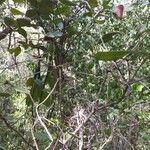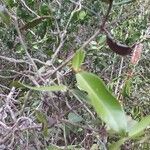Shrub, spiny, much branched, up to 3 m high; branches divaricate, often puberu-1ous, rarely pubescent when young, becoming glabrous; sap milky; spines bifurcate, rarely simple, 2-5 cm long, arising usually in pairs at the apex of a shoot and decussate to the apical leaves, persistent, often bearing in the angle of the fork a reduced or abortive inflorescence. Leaves coriaceous, ovate to ovate-oblong or oblong-lanceolate, 2-4.5 cm long and 1.5-2.4 cm broad, truncate to rounded at the base, apex acute to obtuse, usually mucronulate, glabrous or, rarely, puberulous, shiny above, paler below; secondary nerves 5-12, usually distinct; petiole short, up to 2 mm long, channelled above; axillary glands present; stipules 0. Inflorescence cymose, contracted, sessile at the ends of the branchlets or in the spine-forks, puberulous; bracts lanceolate, acuminate or spine tipped, 3 mm long. Flowers relatively small, white, tinged with red, scented, subsessile. Calyx 2 mm long, puberulous; sepals 4, the inner 2 shorter, ovate, acute to acuminate. Corolla salver-shaped; tube cylindric 9-14 mm long, glabrous or puberulous without, hairy within; lobes 4, rarely 5, ovate to rotund, 3-5 mm long, overlapping to the left, pubescent above. Stamens 4, very rarely 5, inserted at the middle; anthers subsessile, 1.5 mm long. Disc 0. Ovary entire, 2-chambered with up to 8 ovules in each cell; style 3-4 mm long; stigma some distance below the anthers, ellipsoid, apex bifid, hairy. Fruit a berry, subglobose, 7-10 mm in diameter, purple to black, edible. Seeds 4-8, flat, irregularly ovoid in outline; testa rough, hard.
Shrub or tree 1–5 m high; bark brownish grey; spines furcate, sometimes bifurcate or simple, spine axis 0.8–3 cm long, branches 1–6 cm long.. Leaves petiolate; petiole 1–2 mm long, usually 1–3 stipules or bracts present in each leaf axil; blade ovate, elliptic or suborbicular, 1–8 cm long, 0.4–6 cm wide, acute or rounded and mucronate at the apex, cuneate or rounded at the base, glabrous or pubescent, with 12–18 straight pairs of secondary veins.. Inflorescence terminal, few-flowered.. Flowers white inside, pink to red outside; sepals 1–3.4 mm long, ovate to lanceolate, acute to acuminate, cilate; corolla tube 5–19 mm long, lobes overlapping to the left, obovate or elliptic, 2–10 mm long, 2–6 mm wide, rounded, not ciliate; stamens inserted at ± the middle of the tube.. Fruit red to black, subglobose or ellipsoid, 9–20 mm long, 7–10 mm in diameter, 4–8 seeded.
Lamina 1·6-6·3 x 0·4–3 cm., elliptic, lanceolate, ovate-elliptic or subcircular with apex acute to obtuse, mucronate and base rounded to cuneate; margin faintly crenate, flat or somewhat revolute; upper surface silky in appearance, glabrous or pubescent, midrib impressed, lateral nerves raised, indistinct to fairly conspicuous, apparently running right to the margin; lower surface silky, glabrous or pubescent, midrib and lateral nerves raised, the latter indistinct to fairly conspicuous.
A shrub. It grows up to 3 m high. The spines are usually forked and 5 cm long. The leaves are 4.5 cm long by 2.5 cm wide. They are rounded at the base and also often at the tip. They are more pale underneath. The flower clusters are rather small. The fruit are round and 1 cm across. They are purplish-black and have 4 or 5 seeds.
Corolla lobes 2–4 mm. long, broadly elliptic, lower surface glabrous or pubescent, upper surface subglabrous to densely villous near mouth of tube, indumentum (when present) extending into the throat; lobes overlapping to the left.
Spines usually furcate with axis 2–24 mm. long and branches 3–23 mm., sometimes bifurcate; abortive flower sometimes present in the fork of spine branches.
Calyx 1–1·5 mm. long, of two larger and two smaller sepals; sepals ovate-triangular, ± free, dorsally glabrous or minutely puberulous, minutely ciliate.
Shrub, up to 3 m high. Spines bifurcate or rarely simple. Flowers 4-merous. Corolla lobes overlapping to the left. Flowers white, tinged with red.
Gynoecium glabrous; ovary c. 0·5 mm. long, subglobose; style and stigma 2-3 mm. long, stigma not reaching to anthers; clavuncle obscure.
Corolla tube 6·5–1·5 mm. long, externally glabrous or puberulent, internally pubescent in upper 2/3 (density of indumentum variable).
Stamens inserted at or just above the middle of the corolla tube; anthers subsessile, 0·75–1·5 mm. long.
Flowers tetramerous, in sessile or shortly pedunculate few-flowered cymes, white, scented.
Young stems crispate-puberulous, very soon developing a pale grey flaking bark.
Fruit c. 1 cm. long, ellipsoid, red to black, edible, 4–8-seeded.
Leaves moderately coriaceous; petiole 1–2 mm. long.
Low shrub 0·4 m. (or less) to 2 m. high.



